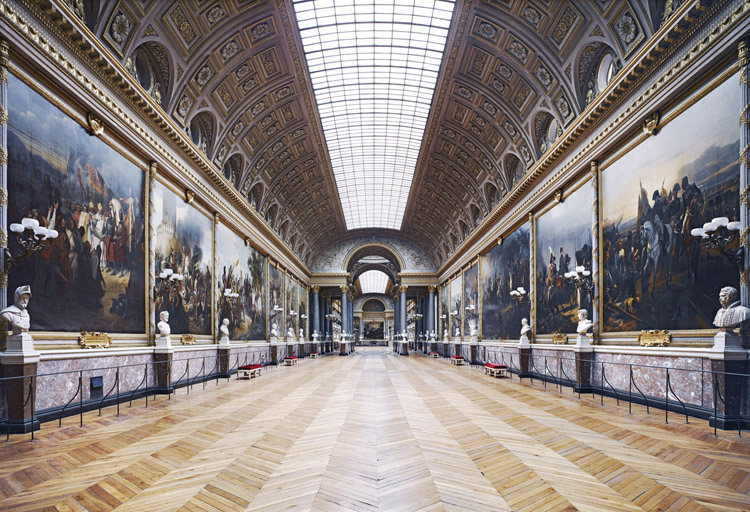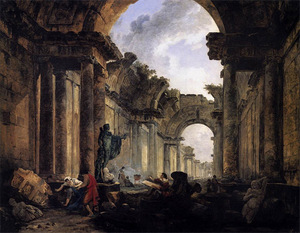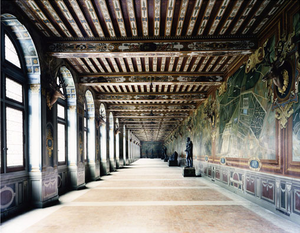This is an archive of the ArtCat Zine, 2007-2009. Please visit our new project, IDIOM.
Candida Höfer at Galerie Yvon Lambert, Paris
"I hope that these views appear to the spectator as they did to me — with a certain coldness."- Candida Höfer
Candida Höfer: Paris Series
8 March - 5 April 2008
Yvon Lambert Paris - 108 rue Vieille du Temple, Paris
The first thing that strikes the viewer about Candida Höfer's photographs is not their technical perfection, which is indubitable, but their sameness. Nearly all are of large, rectangular rooms, taken from the dead center of one of the shorter sides; in most, the light source is a skylight or a row of windows on the left-hand side. Human beings and their personal effects are nowhere to be found. The places depicted include some of Paris' most sumptuous Baroque interiors, yet the Bibliotheque Mazarine comes to look like Fontainebleau, the Bibliotheque du Senat like Versailles — as if the living details of each were an irrelevant and superficial skin over a fixed, immutable framework. In the accompanying video commentary, Höfer notes that she only shoots inside because "exterior spaces offer too many possibilities." Unsurprising.
For me, the most vivid counterpart and contrast to Höfer's work is that of the French Revolutionary artist Hubert Robert (1733-1808). Like Höfer, Robert emphasizes the grandeur of human-made spaces — yet his paintings lack the stillness and serenity of Höfer's photographs. He paints almost nothing but ruins: the destruction of bridges, the perishing in fire of great buildings, the crumbling hulks of vaguely classical temples. Perhaps his most famous work is an imagined scene of the Grand Gallery of the Louvre in ruins, the vaulted ceiling caved in, a cooking fire where statues once stood. Robert's subjects, both the ruins themselves and the people that inhabit them, are presented in their utmost vulnerability to history; like Robert himself, they live in a world constantly overshadowed by historical rupture, where even the solidity of stone is no guarantee of permanence.
Höfer's spaces are timeless and changeless. Aside from a few stray computer screens in one photo, and the modernist architecture of another, they betray nothing of their historical context. One imagines Louis XIV just outside the frame of the Fontainebleau photographs, revoking the Edict of Nantes; indeed, all the works seem to be filled with an admiration for the monarchy, luxe, calme, et volupté. Where Robert's works are always crawling with people, Höfer's only exist to be looked at, as a cat may look at a king.
"Capitalist production has unified space," wrote Guy Debord. "In order to become ever more identical to itself, to get as close as possible to motionless monotony, the free space of the commodity is henceforth constantly modified and reconstructed." But in Höfer's photographs, this constant creative destruction and reinvention of space has become superfluous; they represent motionless monotony attempted and achieved. Coldness, distance, a feeling of smallness and isolation: these, in the words of Höfer herself, are the aesthetic effects of her work. They are the features of a space no longer lived, but spectacular. Who can help feeling small and distant when faced with a built environment from which all trace of the human has been erased?
It would be simple-minded to dismiss Höfer as a reactionary. She seems as ambivalent about her work's implications as the spectator is forced to be. It is courageous of her to present these images drained of all subjective content, to voluntarily renounce every emotional appeal and political harangue; there is something here of the clinical genius of the late Robbe-Grillet. Yet, despite the undeniable power of these enormous prints, it is difficult to like them. A minimalist white-on-white canvas or a Duchamp ready-made can provoke anger in people accustomed to more representational styles of art; her works are as immune to any such fury as to rapture. Perhaps that is only because the mirror she holds up to the spectacle is a little too accurate, too familiar, to inspire much emotion.
ZINE
HOME
TIPS / COMMENTS
CATEGORIES
CONTRIBUTORS
- Greg Afinogenov
- B. Blagojevic
- Adda Birnir
- Susannah Edelbaum
- Julie Fishkin
- Paddy Johnson
- Jessica Loudis
- Christopher Reiger
- Andrew Robinson
- Peter J. Russo
- Blythe Sheldon
- S.C.Squibb
- Hrag Vartanian



